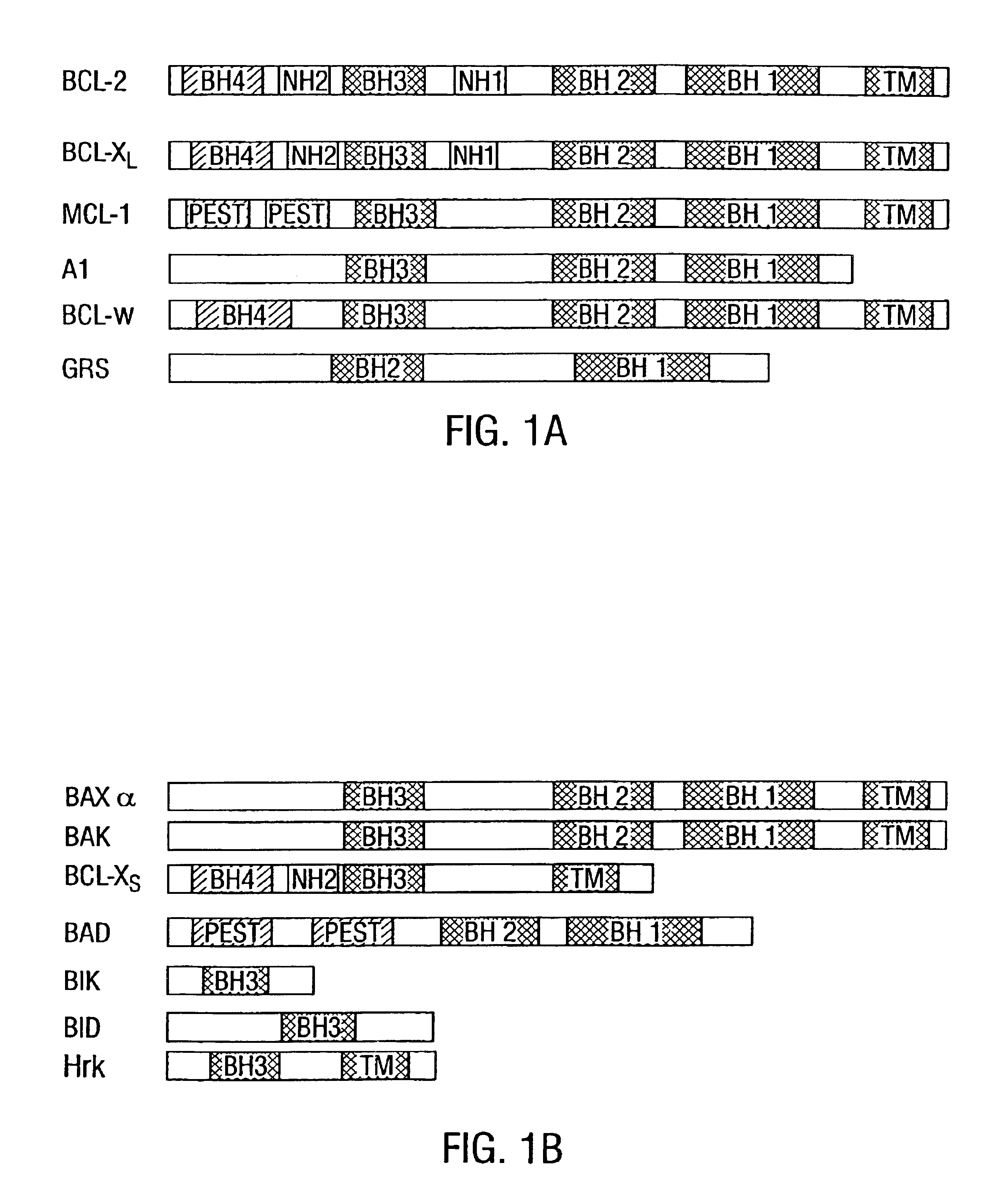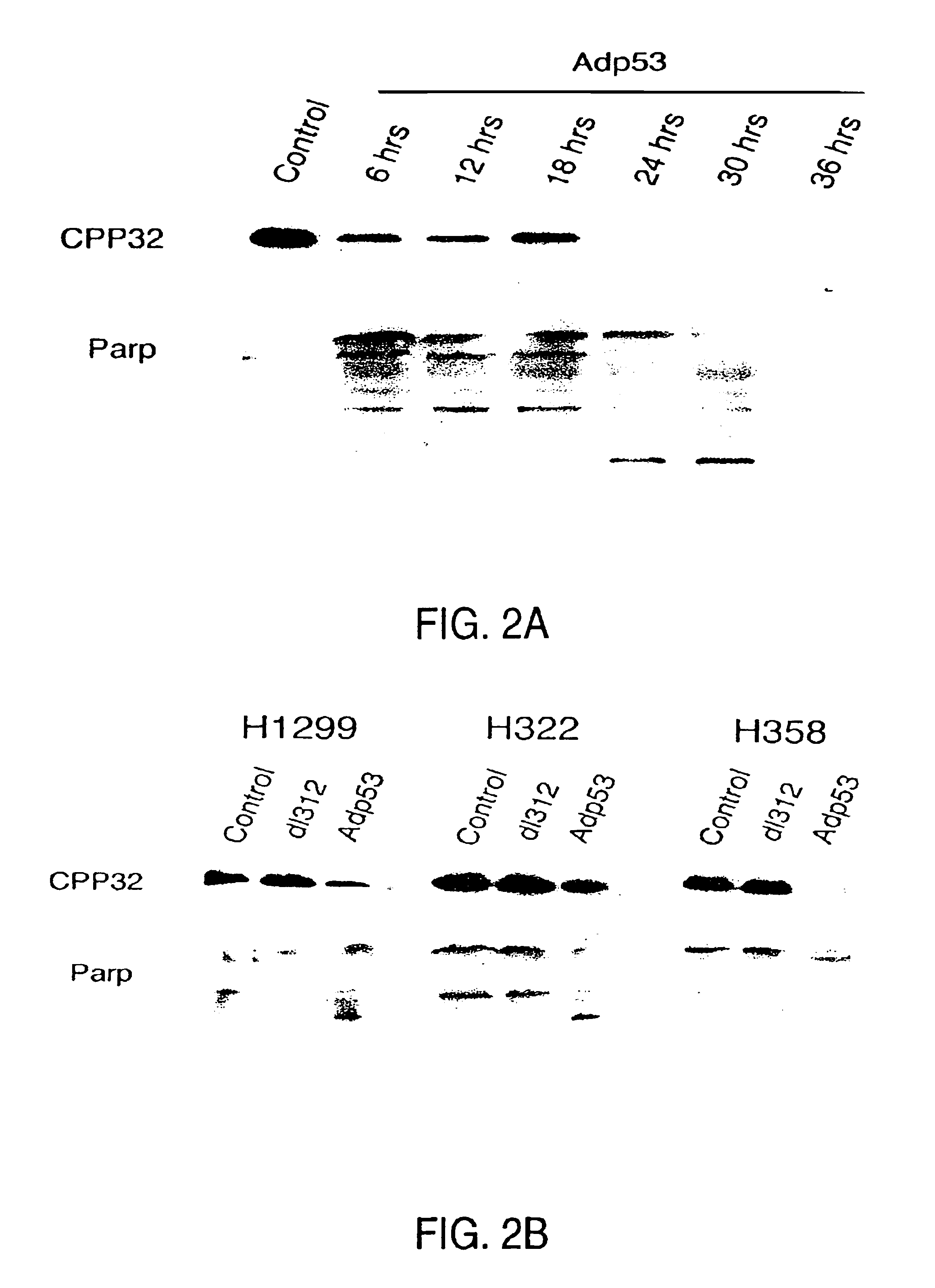Induction of apoptic or cytotoxic gene expression by adenoviral mediated gene codelivery
a technology of adenoviral mediated gene codelivery and apoptic or cytotoxic gene expression, which is applied in the field of viral vectors, can solve the problems of host cell toxicity and/or immune response risks of viral material administered
- Summary
- Abstract
- Description
- Claims
- Application Information
AI Technical Summary
Benefits of technology
Problems solved by technology
Method used
Image
Examples
example 1
Apoptotic Mechanisms following Adenovirus-mediated
p53 Replacement Gene Therapy
[0294]Induction of program cell death pathway is a critical step in most anticancer therapies including adenovirus mediated wild-type p53 gene therapy. The transient expression of the adenovirus vector requires either induction of apoptosis, terminal differentiation, or cellular senescence in order to result in effective therapy. As the a further understanding of the mechanisms involved in this process is gained, this will enable us to design more effective therapeutic approaches to anticancer treatment.
Materials and Methods
[0295]Cell Culture. H358 and H1299 are non-small cell lung cancer cell lines with both copies of the p53 deleted and were obtained from A. Gazdar and J. Minna. H322j is a non-small cell lung cancer cell line with a p53 mutation. Cells were maintained in RPMI-1640 medium supplemented with 10% fetal calf serum, 10 mM glutamine, 100 units / ml of penicillin, 100 μg / ml of streptomycin, and 0....
example 2
[0313]The Adenoviral Bax Vector
[0314]Using the insights gained herein above, the inventors reasoned that the overexpression of p53 gene induces apoptosis by upregulating Bax. Thus if a vector could be designed that in itself mediated the upregulation of over-expression of Bax, there may be enough of an induction of Bax to induce apoptosis. In order to investigate this further the inventors constructed a new and novel adenoviral Bax vector as described herein below.
[0315]Cloning of the human Bax cDNA.
[0316]Total RNA was isolated from SRB I squamous cell carcinoma cell line using Ultraspec RNA isolation reagent (Biotecx). First strand cDNA was synthesized using 5 μg of RNA, 500 ng oligo (dT), 5× strand buffer, 0.1M DTT, 10 μM dNTP mix 1 μl of superscripapt II™ in a RT-PCR™ reaction. Polymerase chain reaction was then performed to amplify Bax cDNA using forward oligo primer 5′-GGAATTCGCGGTGATGGAC GGGTCCGG-3′ (SEQ ID NO:5) and reverse oligo primer 5′-GGGAATTCTCAGCCCATCTTCTTCCA GA-3′ (SE...
example 3
Induction of Apoptosis in Human Breast Cancer by Adenoviral Mediated Overexpression of Bax
[0321]Apoptosis is controlled, at least in part, by the balance between the proapoptotic (Bax, Bak, Bcl-xs) and antiapoptotic (Bcl-2, Bcl-XL) members of the Bcl-2 family. Altering the balance of these mediators can result in the suppression or induction of apoptosis. The present example describes the use of the novel adenoviral vector, Ad-Bax, to determine whether overexpression of Bax could induce apoptosis in human breast cancer.
[0322]The human Bax cDNA was isolated, sequenced and used to construct the Type 5, E1 deleted adenoviral vector as described herein above. The Ad-Bax vector contained a truncated Bax with an intact death (BH3) domain. Human breast cancer cell lines MDA-MB-468, SKBr3 and MCF-7 were transduced with Ad-Bax, E1 deleted viral control (AdV) or media alone (Cont.) at multiplicity of infection (MOI) of 100 to achieve an 85% transduction efficiency.
[0323]Apoptosis was evaluate...
PUM
| Property | Measurement | Unit |
|---|---|---|
| delay time | aaaaa | aaaaa |
| delay time | aaaaa | aaaaa |
| delay time | aaaaa | aaaaa |
Abstract
Description
Claims
Application Information
 Login to View More
Login to View More - R&D
- Intellectual Property
- Life Sciences
- Materials
- Tech Scout
- Unparalleled Data Quality
- Higher Quality Content
- 60% Fewer Hallucinations
Browse by: Latest US Patents, China's latest patents, Technical Efficacy Thesaurus, Application Domain, Technology Topic, Popular Technical Reports.
© 2025 PatSnap. All rights reserved.Legal|Privacy policy|Modern Slavery Act Transparency Statement|Sitemap|About US| Contact US: help@patsnap.com



